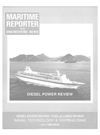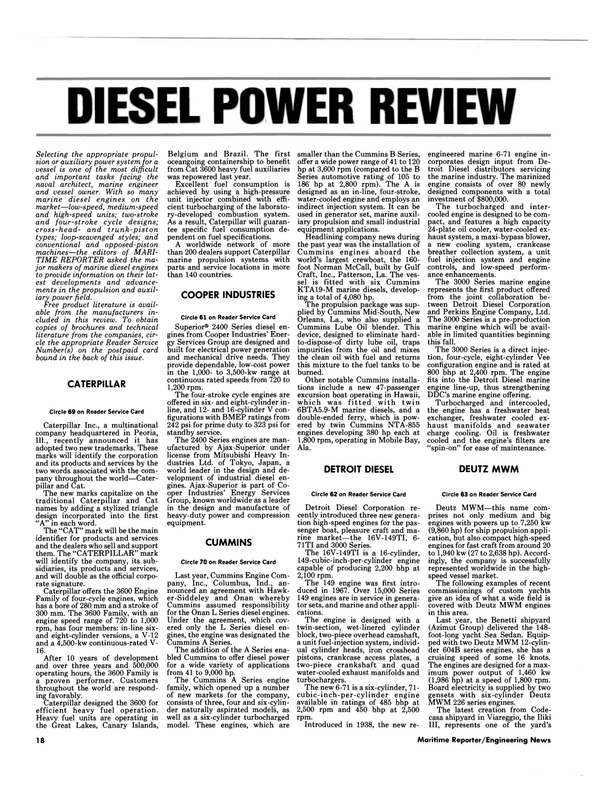
New Medium-Speed Engine Presented By MAN B&W Diesel At Augsburg Press Conference
New Engine Diagnosis And Trend System Also Displayed MAN B&W Diesel GmbH recently held an international press conference and demonstration in Augsburg, West Germany, to present its latest addition, L48/60, to its largebore medium-speed diesel engine family, as well as a new engine diagnosis and trend system from MAN B&W and AEG A/G of Hamburg.
At the conference, the firm introduced the entire three-member medium- speed engine family—the L58/64, L48/60 and L40/58—ranging in power from 3,300 to 12,000 kw (4,425 to 16,092 hp) at 400 to 514 rpm. MAN B&W demonstrated a model 6L 48/60 engine on the test bench at its Augsburg works. The new L48/60 plugged the output gap between the L58/64 and L40/54 with its 885 kw per cylinder at a speed of 450 rpm.
Also demonstrated at the conference was the MODIS-Geadit, a joint development of MAN B&W and AEG, an engine diagnosis and trend system.
Prior to the engine demonstration, a conference was opened by Rudolf Rupprecht, Dipl.-Ing., Dipl. Wirt.-Ing., the board of management, MAN B&W Diesel GmbH.
Other company dignitaries speaking at the conference included: Folker Bohm, Dipl.-Ing., vice president of sales and marketing, who presented a paper on "Large-Bore Medium- Speed Engines in the Market of the 90s"; Hanns-Gunther Bozung, Dr.-Ing., vice president of engineering, who spoke on "Three Medium- Speed Engines—One Design Concept; Our Solution for the 90s"; Dipl.-Ing. Lochbichler, head of the engine design department; Dr.
Lausch, who spoke on the MODISGeadit engine diagnosis system; and Rudolf Erhardt, Dipl.-Ing., vice president of diesel engine service, who presented the paper "QE2 Propulsion Plant—Our Service Philosophy in Practice." Following the conference, the press was taken to test stand for a first-hand demonstration of a new model 6L48/60 diesel in a test bed.
During the testing of the engine at normal operating speeds, several observers, some as close as 12 feet, commented on the lack of any discernible vibration. The demonstration verified the remarkable engi- neering feat that MAN B&W has accomplished with its new mediumspeed family.
Beginning with the largest engine, the L58/64, MAN B&W has created an engine series for a class of toprated engines designed with a view of achieving economy and reliability and equipped with every manner of future-orientated, technical and economical design characteristics.
With a piston diameter of 580 mm and a stroke of 640 mm, the L58/64 engine develops a cylinder output of 1,325 kw at a speed of 428 rpm, i.e., in the nine-cylinder version the engine is capable of an output of approximately 12,000 kw.
The "little brother," L40/54, which successfully completed its test bench trials at the end of 1987, with its cylinder output of 665 kw, is modeled on the basic design concept of the L58/64 engine, an engine that has since proved itself in operation in numerous ships' propulsion plants.
The L48/60 engine plugs the output gap between the 40/54 and the 58/64 with its 885-kw per cylinder at a speed of 450 rpm. This engine was also modeled on the same futureorientated design concept.
All three engines are supplied as in-line configuration engines with between six and nine cylinders.
The principle design features of the MAN B&W medium-speed engine generation include: Rigid monoblock frame casing; underslung crankshaft; individual cylinder jackets, resulting in minimum deformation from gas and mass forces and thermal influences; connecting rod—optimized marine head design with parting line in the upper region of the rod shaft, i.e., extremely low overhauling height; exhaust valves arranged in cages resulting in simplified maintenance of components.
Also, propellers on the exhaust valve cones, resulting in rotation of the valve by the gas flow—valve seats remain free of deposits over many thousands of operating hours; fuel-optimized injection system with "economy plunger" and highinjection intensity; adjusting mechanism for optimizing the injection timing during engine operation; constant pressure turbocharging, i.e., higher turbocharger efficiency and low component temperatures; high compression ratio and correspondingly adjusted valve timing for problem-free and trouble-free HFO operation; consistently even exhaust gas temperature after turbine over a broad operating range ensures optimum utilization of waste heat.
MAN B&W exhaust gas turbocharger with a very high level of aggregate efficiency over the entire load range permits a part of the exhaust gas flow to be branched off and utilized in a turbo-compound system, thus raising the aggregate efficiency of the propulsion plant; resilient mounting of the engines— the rigid design makes it possible to arrange the resilient bearing elements directly on the engine lands.
Low maintenance requirement thanks to an optimized maintenance concept: with only three different hydraulic tools, all the main screw connections can be slackened and re-tightened; rocker arm covers can be opened without great physical exertion and fix themselves in the open position; and the design and arrangement of the rocker arms makes for swift and simple removal of the exhaust valves.
According to MAN B&W, their new generation of medium-speed engines offer further reductions in fuel consumption rates (85% ECR): L40/54—172 b/kWh, L48/60—169 g/kWh, and L58/64—167 g/kWh; lube oil consumption rates of less than 1 g/kWh; significant reductions in pollutant emission levels; extensive utilization of various engine waste heats, resulting in a high aggregate efficiency of the propulsion system; long wear component lifetime and thus a low spare parts requirement; a simple maintenance concept tailored to the practice of day-to-day engine operation ensures short maintenance and turnaround times, which in turn means high engine availability and reduced manning levels.
Jointly developed by MAN B&W Diesel and AEG, the MODIS-Geadit assumes the task of an engine expert in diagnosing the engine condition.
The system makes the expertise of the engine builders available to the engine operator.
Ignition and combustion behavior of the fuels and their influence on the engine operation are diagnosed using the software that has been utilized by MAN B&W in its engine development work.
The diagnoses are based on physical correlations, making MODISGeadit applicable for use in both two-stroke and four-stroke engine plants.
The MODIS-Geadit aids the engine operator in ensuring cost-effective operation of the ship by: (1) continuous diagnosis of the engine condition; (2) avoidance of operational disturbances—reduced downtimes and reduction of running costs; (3) targeted planning of maintenance work—TBOs lengthened and reduction of running costs; (4) support and decision aid for onboard personnel; (5) reduction in the risk of downtimes; and (6) electronic expert, knowledge permanently available and extendible.
The MODIS-Geadit can diagnose such events as: (1) contamination of the air intake filter, charge air cooler or exhaust gas boiler; (2) irregularities in combustion; (3) deterioration in the condition of injector pumps and nozzles; (4) deterioration in the condition of combustion space components; (5) engine operation in excess of permissible range; or (6) imbalance condition of the exhaust gas turbocharger.
For more information and free color brochures and literature detailing MAN B&W engines or the new engine diagnosis system MODIS- Geadit, Circle 109 on Reader Service Card
Read New Medium-Speed Engine Presented By MAN B&W Diesel At Augsburg Press Conference in Pdf, Flash or Html5 edition of July 1989 Maritime Reporter
Other stories from July 1989 issue
Content
- L & L Oil Stocks Wide Variety Of Standard And Custom Lubricants page: 5
- E.N. Bisso And Son Begins Long Distance Towing page: 7
- $200 Billion Needed Over Next Decade For World Fleet Replacement page: 8
- Proposed T-Boat Rules Changes To Affect Lifesaving Equipment page: 9
- Trinity Marine Group Enters Megayacht Construction With Establishment Of Trinity Yachts, Inc. page: 10
- MAN B&W Celebrates 1,000th 20/27 Engine To Be Sold page: 11
- Tinkey, Guthans, And Farrell Elected To Key AWO Posts page: 11
- 'Rapid Response Team' Formed By ABS To Assist Clients When Vessels Are Damaged page: 11
- Detroit Diesel-Powered 'Spirit Of Philadelphia' Delivered By Blount Marine—Its 277th Vessel page: 12
- New Revolutionary River Radar System Launched By Kelvin Hughes page: 13
- National Waterways Conference To Hold Annual Meeting In St. Louis page: 13
- Repair Contract For Third 'Knox' Class Ship In Seven Months page: 14
- New Medium-Speed Engine Presented By MAN B&W Diesel At Augsburg Press Conference page: 16
- Halter Converts Supply Boat For USCG Drug Surveillance Mission page: 17
- DIESEL POWER REVIEW page: 18
- OUTLOOK FOR THE $35-BILLION ANNUAL NAVY SHIPBUILDING MARKET page: 25
- MARINE LUBRICANTS MEETING THE DEMANDS OF NEW AND UPGRADED DIESELS page: 36
- Free Color Brochure Details New Doucette High Tech Condenser page: 43
- James Bolger Of Colonna's Shipyard Addresses Technical Staffs Of Leading Shipowners page: 44
- 360-Passenger 'Wave Piercer' Delivered By Nichols Brothers page: 44
- Coast Guard To Reexamine Rules On Ship Repair page: 46
- Si-Tex Introduces Next Generation Electronic Charting System page: 53
- MSI Opens Fourth Diesel Engine Repair Facility In St. Louis page: 53
- Barber Industries' 'Rigsaver' Assures Mobile And Stationary Engine Overspeed Protection page: 55


